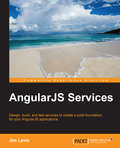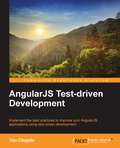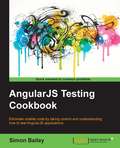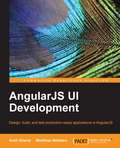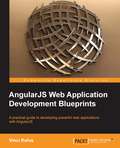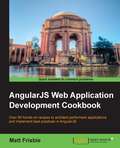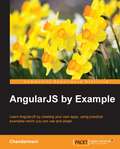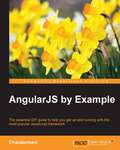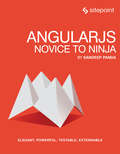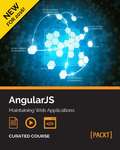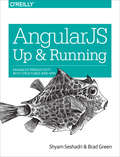- Table View
- List View
AngularJS Services
by Jim LavinIf you are an intermediate JavaScript developer who is looking to enhance your understanding of single-page web application development with a focus on AngularJS services, then this book is for you.
AngularJS Test-driven Development
by Tim ChaplinThis book is for developers who want to learn about AngularJS development by applying testing techniques. You are assumed to have a basic knowledge and understanding of HTML, JavaScript, and AngularJS.
AngularJS Testing Cookbook
by Simon BaileyThis book is intended for developers who have an understanding of the basic principles behind both AngularJS and test-driven development. You, as a developer, are interested in eliminating the fear related to either introducing tests to an existing codebase or starting out testing on a fresh AngularJS application. If you're a team leader or part of a QA team with the responsibility of ensuring full test coverage of an application, then this book is ideal for you to comprehend the full testing scope required by your developers. Whether you're new to or are well versed with AngularJS, this book will guarantee a complete understanding of your application code and help reduce the cost of bugs.
AngularJS UI Development
by Amit Gharat Matthias NehlsenThis book is ideal for developers who have some experience in Java application development as well as some basic knowledge of test doubles and JUnit testing. This book also introduces you to the fundamentals of JUnit testing, test doubles, refactoring legacy code, and writing JUnit tests for GWT and web services.
AngularJS Web Application Development Blueprints
by Vinci RufusIf you are a web application developer interested in using AngularJS for a real-life project, then this book is for you. As a prerequisite, knowledge of JavaScript and HTML is expected, and a working knowledge of AngularJS is preferred.
AngularJS Web Application Development Cookbook
by Matt FrisbieThis is not your grandmother's JavaScript cookbook. If you have a foundational understanding of the framework and want to expand your AngularJS skillset with strategies and methodologies for building performant and scaleable production applications, this is the book for you. This book assumes you have an understanding of the basics of AngularJS, and experience with JavaScript.
AngularJS by Example
by ChandermaniIf you've always wanted to get started with AngularJS, this is an essential guide designed to help you do exactly that. Start building applications immediately with the featured examples, and uncover a simpler approach to JavaScript web development. You will need some prior experience with HTML, CSS, and JavaScript to get started.
AngularJS by Example
by Chandermani<P><P>Learn AngularJS, and tackle the challenges of modern web development by creating your own applications with these practical examples you can use and adapt <P><P>About This Book <P><P>Learn the AngularJS development workflow and uncover a more effective way to build, deploy, and test applications <P><P>Explore the core components of AngularJS and find out how it makes JavaScript web development easier <P><P>Learn by example, as you create increasingly more complex real-world applications and dive deeper into AngularJS <P><P>Who This Book Is For <P><P>If you've always wanted to get started with AngularJS, this is an essential guide designed to help you do exactly that. Start building applications immediately with the featured examples, and uncover a simpler approach to JavaScript web development. You will need some prior experience with HTML, CSS, and JavaScript to get started. <P><P>What You Will Learn <P><P>Get to grips with Angulara ™s Model-View-Controller architecture Gain a understanding of single page applications from an AngularJS perspective <P><P>Manage code organization using modules and component dependencies with the Dependency Injection Framework <P><P>Find out how to use AngularJS directives to extend the behavior of HTML on your web page <P><P>Effectively use a range of JavaScript tools, from extending your app with jQuery plugins, to testing with Jasmine <P><P>Create forms for your single page applications and see how Angular helps you to bind, validate, and submit form data <P><P>In Detail <P><P>AngularJS makes web JavaScript web development less painful and more organized – it's unsurprising that today it's one of the most popular tools in web development. <P><P>AngularJS by Example helps you get started with this essential web development framework quickly and easily, guiding you through AngularJS by showing you how to create your own real-world applications. By adopting this approach, you can bridge the gap between learning and doing immediately, as you follow the examples to learn the impressive features of Angular and experience a radically simple–and powerful–approach to web development. <P><P>You'll begin by creating a simple Guess the Number game, which will help you get to grips with the core components of Angular, including its MVC architecture, and learn how each part interacts with one another. This will give you a solid foundation of knowledge from which you can begin to build more complex applications, such as a 7 minute workout app and an extended personal trainer app. By creating these applications yourself, you will find out how AngularJS manages client-server interactions and how to effectively utilize directives to develop applications further. You'll also find information on testing your app with tools such as Jasmine, as well as tips and tricks for some of the most common challenges of developing with AngularJS. <P><P>AngularJS by Example is a unique web development book that will help you get to grips with AngularJS and explore a powerful solution for developing single page applications.
AngularJS in Action
by Lukas RuebbelkeSummaryAngularJS in Action covers everything you need to know to get started with the AngularJS framework. As you read, you'll explore all the individual components of the framework and learn how to customize and extend them. You'll discover the emerging patterns for web application architecture and tackle required tasks like communicating with a web server back-end. Along the way, you'll see AngularJS in action by building real world applications with thoroughly commented code.Purchase of the print book includes a free eBook in PDF, Kindle, and ePub formats from Manning Publications.About the TechnologyAngularJS is a JavaScript-based framework that extends HTML, so you can create dynamic, interactive web applications in the same way you create standard static pages. Out of the box, Angular provides most of the functionality you'll need for basic apps, but you won't want to stop there. Intuitive, easy to customize, and test-friendly, Angular practically begs you to build more interesting apps.About the BookAngularJS in Action teaches you everything you need to get started with AngularJS. As you read, you'll learn to build interactive single-page web interfaces, apply emerging patterns like MVVM, and tackle key tasks like communicating with back-end servers. All examples are supported by clear explanations and illustrations along with fully annotated code listings.This book assumes you know at least some JavaScript. No prior exposure to AngularJS is required.What's InsideGet started with AngularJSWrite your own componentsBest practices for application architectureProgressively build a full-featured applicationCovers Angular JS 1.3Sample application updated to the latest version of AngularAbout the AuthorLukas Ruebbelke is a full-time web developer and an active contributor to the AngularJS community.Table of ContentsPART 1 GET ACQUAINTED WITH ANGULARJSHello AngularJSStructuring your AngularJS applicationPART 2 MAKE SOMETHING WITH ANGULARJSViews and controllersModels and servicesDirectivesAnimationsStructuring your site with routesForms and validationsAPPENDIXESSetting up KarmaSetting up a Node.js serverSetting up a Firebase serverRunning the app
AngularJS: Elegant, Powerful, Testable, Extendable
by Sandeep PandaAngularJS: Novice to Ninja is your fast track route to mastering AngularJS, the superheroic JavaScript framework. AngularJS provides the fastest, most efficient way to build single page web applications.What will I learn?In this practical and fun-to-read book, you'll learn the fundamentals of AngularJS, such as scopes, modules and controllers. You'll then move on to more sophisticated techniques, including using directives, filters and expressions to build a full single page web application.Discover the power of AngularJS's two-way data bindingUsing AngularJS and TDDGet to grips with modules, scopes, and controllersEnhance your HTML with directivesBuild a complete working single page blog application as you learn And much more
AngularJS: Maintaining Web Applications
by Rodrigo Branas Amos Q. Haviv Matt Frisbie ChandermaniGet started with speed building AngularJS applications, and scale up to a full-stack web application, using the existing AngularJS framework without the trouble of migrating to Angular 2 About This Book • Follow the best practices of the framework to organize and modularize your application • Get to grips with Angular's Model-View-Controller architecture • Create application modules with maximum reusability and extensibility • Structure and use AngularJS applications in your MEAN project Who This Book Is For This course is for people who want to discover how they can improve their current web applications with the existing version of Angular without having to worry much about migrating to AngularJS 2. What You Will Learn • Install and set up the AngularJS framework • Create your own full-featured and robust AngularJS web apps • Create reusable directives and then extend the behavior of HTML on your web page • Master the most difficult aspects of AngularJS such as animation, testing, and promises • Optimize and maintain your web applications • Create more powerful full-stack web applications, that draw on the combined power of AngularJS, Node.js, MongoDB, and Express in the MEAN stack In Detail The AngularJS course is a journey to help you improve and scale your current web applications with the existing version of Angular without having to worry about migration to Angular 2. The course is divided into four modules. The first part—AngularJS Essentials is like a practical guide, filled with many step-by-step examples that will lead you through the best practices of AngularJS. After a brief introduction, you will learn how to create reusable components with directives. You will then take a look at many data handling techniques, discover a complete set of technologies that are capable to accomplish any challenge related to present, transform, and validate data on the user's interface. Finally, you will discover the best way to deal with the scope and how to break up the application into separate modules, giving rise to reusable and interchangeable libraries. With this you've crossed a milestone and are about to enter the world of learning by example. In the next part—Learning AngularJS By Example, you will learn how to effectively build apps using the AngularJS platform. You will be building multiple apps on this platform ranging from simple ones to more complex ones. In this module, you will roll up your coding sleeves and create a serious AngularJS application by example – a rich featured workout app. Take the coding a step at a time at first, then once you're coding a full app in this module, a lot of AngularJS will fall right into place for you. The third module—AngularJS Web Application Development Cookbook, will get you accustomed to the AngularJS concept armed with a solid understanding of how it works, insight into the best ways to wield it in real-world applications, and annotated code examples. It is a rich library of AngularJS coding solutions that you can use straight away in your own code projects. You can even improve and maintain the workout app you built in the earlier module in this course. You are just a step away from completing this learning path of AngularJS. The name of the next part—MEAN Web Development itself assures that you are nearing the destination. The idea is simple with this part, you'll take MongoDB as the database, Express as the web framework, AngularJS as the frontend framework, and Node.js as the platform, and combine them together in a modular approach that will ensure the flexibility needed in modern software development. This is also your graduation to full-stack web development, which can open many new coding and career opportunities for you! Style and approach Get up to speed building AngularJS applications, then improve and scale full-stack web applications, using the existing AngularJS framework without the trouble of migrating to Angular 2
AngularJS: Up and Running
by Shyam Seshadri Brad GreenIf you want to get started with AngularJS, either as a side project, an additional tool, or for your main work, this practical guide teaches you how to use this meta-framework step-by-step, from the basics to advanced concepts. By the end of the book, you'll understand how to develop a large, maintainable, and performant application with AngularJS.Guided by two engineers who worked on AngularJS at Google, you'll learn the components needed to build data-driven applications, using declarative programming and the Model-view-controller pattern. You'll also learn how to conduct unit tests on each part of your application.Learn how to use controllers for moving data to and from viewsUnderstand when to use AngularJS services instead of controllersCommunicate with the server to store, fetch, and update data asynchronouslyKnow when to use AngularJS filters for converting data and values to different formatsImplement single-page applications, using ngRoute to select views and navigationDive into basic and advanced directives for creating reusable componentsWrite an end-to-end test on a live version of your entire applicationUse best practices, guidelines, and tools throughout the development cycle
Angus Cartwright IV
by William J. Poorvu Howard H. Stevenson Arthur I Segel John H. Vogel Jr. Kenneth J. HattenJudy and John DeRight, looking to diversify their investment portfolios, have retained Angus Cartwright, Jr. to identify prospective real estate acquisitions. Mr. Cartwright has four potential properties that he feels merit an in-depth financial analysis. The case provides an opportunity to examine the various components of real estate return--cash flow, tax benefits, and futures--and measure the profitability of a proposed investment through the calculation of net present value, internal rate of return, and capitalization rate.
Angus Cartwright, III
by William J. Poorvu Howard H. Stevenson Arthur I Segel John H. Vogel Jr. Kenneth J. HattenJudy and John DeRight, looking to diversify their investment portfolios, have retained Angus Cartwright, Jr. to identify prospective real estate acquisitions. Mr. Cartwright has four potential properties that he feels merit an in-depth financial analysis. The case provides an opportunity to examine the various components of real estate return--cash flow, tax benefits, and futures--and measure the profitability of a proposed investment through the calculation of net present value, internal rate of return, and capitalization rate.
Angus L. Macdonald
by T. Stephen HendersonPerhaps one of the most influential Canadian premiers of the Twentieth Century and one of the leading political intellectuals of his generation, Angus L. Macdonald dominated politics in Nova Scotia for more than twenty years, serving as premier from 1933 to 1940 and again from 1945 until his death in 1954. One rival referred to him as "the pope" out of respect for his political infallibility. From 1940 to 1945 Macdonald guided Canada's war effort at sea as Minister of National Defence for Naval Services; under his watch, the Royal Canadian Navy expanded faster than any other navy in the world.This new work by T. Stephen Henderson is the first academic biography of Macdonald, whose life provides a framework for the study of Canada's pre- and post-war transformation, and a rare opportunity to compare the political history of the two periods. Generally, Macdonald's political thinking reflected a progressive, interwar liberalism that found its clearest expression in the 1940 Rowell-Sirois report on federal-provincial relations. The report proposed a redistribution of responsibilities and resources that would allow poorer provinces greater autonomy and reduce overlapping jurisdictions in the federal system. Ottawa abandoned Rowell-Sirois in the postwar period, and Macdonald fell out of step with the national Liberal party that he had once seemed destined to lead. Within Nova Scotia, however, his ardent defence of provincial powers and his commitment to building a modern infrastructure enabled him to win election after election and transform the face and identity of his province.
Angus Lost
by Marjorie FlackAngus learns that the grass is not always greener on the other side when he sets off to seek new adventures and becomes lost.
Angus Lost (Angus and the Cat #3)
by Marjorie FlackAlways curious, Angus runs away from his house to seek new adventures. Find them he does, but will Angus make it back home? Find out in the third book in Marjorie Flack's lovable picture book series, Angus Lost. "Delightful in text and pictures." --Chicago Daily Tribune
Angus and Sadie
by Cynthia VoigtAngus is black and white and strong. Sadie is reddish brown and white and small. "They don't look much alike," says Missus. "They don't act much alike," says Mister. Angus and Sadie are brother and sister. Angus is bigger. He is a good, brave, and clever dog -- and he likes that. Sadie isn't as quick to learn -- or to obey. When cats jump at her, she yelps and runs away. Angus thinks that means she's scared of everything. But Sadie isn't so sure that's true. Newbery Medalist Cynthia Voigt's story of border collie puppies growing up on a farm in Maine is for animal lovers of all ages, and for anyone who's ever had -- or wondered what it would be like to have -- a brother or sister just like themselves, but very, very different.
Angus and the Cat (Angus and the Cat #2)
by Marjorie FlackFrom Caldecott Honor-winning children’s author and illustrator Marjorie Flack comes an adventure featuring her beloved Scottish terrier who must learn to get along with a new member of the family in Angus and the Cat. Angus’s world is turned upside down when a feline joins the household. She’s eating his food, napping in his favorite sun-filled places, and jumping out of reach whenever he chases her. Peace and quiet resumes when the cat disappears, but Angus finds himself missing his new friend.
Angus and the Cat (Fountas & Pinnell LLI Blue #Level I)
by Marjorie FlackWhat happens when a cat comes into Angus’ life.
Angus and the Ducks
by Marjorie FlackA curious little puppy has a scary encounter with some very loud ducks.
Angus and the Ducks (Angus and the Cat #1)
by Marjorie FlackWhen Angus, a very curious young terrier, sees that the door is open one day, he decides to go exploring. Little does he know what neighbors await him!Farrar, Straus and Giroux is proud to reintroduce Angus and the Ducks, along with its companion books, Angus and the Cat and Angus Lost. These classic tales of the feisty, lovable Angus will once again delight children everywhere.
Angus and the Ducks (Fountas & Pinnell LLI Blue #Level I)
by Marjorie FlackAngus encounters two ducks as he crosses over the hedge.
Angus's Lost Lady (Families Are Forever Ser. #1)
by Marie FerrarellaIn this classic romance by a USA Today–bestselling author, a private eye and single dad helps a beautiful amnesiac. Private detective Angus MacDougall was used to finding missing persons. But the woman standing before him was a completely different story. She had absolutely no idea who she was.From the first, he wanted her. But he knew that the delicate mystery woman wouldn’t remain unclaimed for long. Some lucky man would come for her, and Angus would lose her forever. He couldn’t let his young daughter start calling her “Mommy.” Yet how could he resist this precious lost lady when she’d already claimed both their hearts?
Angus, Thongs and Full-Frontal Snogging (Confessions of Georgia Nicolson #1)
by Louise RennisonPresents the humorous journal of a year in the life of a fourteen-year-old British girl who tries to reduce the size of her nose, stop her mad cat from terrorizing the neighborhood animals, and win the love of handsome hunk Robbie.
